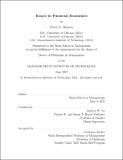| dc.description.abstract | Chapter 1 introduces novel preference formulations which capture aversion to ambiguity about unknown and potentially time-varying volatility. These preferences are compared with Gilboa and Schmeidler's maxmin expected utility as well as variational formulations of ambiguity aversion. The impact of ambiguity aversion is illustrated in a simple static model of portfolio choice, as well as a dynamic model of optimal contracting under repeated moral hazard. Implications for investor beliefs, optimal design of corporate securities, and asset pricing are explored.
Chapter 2 develops a method informed by data and models to recover information about investor beliefs. This approach uses information embedded in forward-looking asset prices in conjunction with asset pricing models. We step back from presuming rational expectations and entertain potential belief distortions bounded by a statistical measure of discrepancy. Additionally, this method allows for the direct use of sparse survey evidence to make these bounds more informative. Within this framework, market-implied beliefs may differ from those implied by rational expectations due to behavioral/psychological biases of investors, ambiguity aversion, or omitted permanent components to valuation. Formally, evidence about investor beliefs is represented as a nonlinear expectation function deduced using model-implied moment conditions and bounds on statistical divergence. This method is illustrated with a prototypical example from macro-finance using asset market data to infer belief restrictions for macroeconomic growth rates.
Chapter 3 develops diagnostic tools to assess whether individual factor risk premia are identified from return data. We describe a necessary and sufficient condition for population identification, which we call the kernel-orthogonality condition. This condition can be thought of intuitively as the existence of a “true” factor mimicking portfolio, and is weaker than the standard rank condition commonly assumed for linear factor models. Furthermore, this condition remains meaningful even if the factor model is misspecified, as a condition for the identification of the factor risk premium consistent with minimal pricing error. We discuss test procedures to assess identification, and provide a novel test of the kernel-orthogonality condition in reduced-rank models. Finally, we apply our test methodology to assess identification of risk premia associated with consumption growth and intermediary leverage. | |
